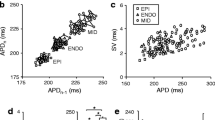Abstract
The objective of this study was to evaluate the electrophysiologic characteristics of Crista terminalis (CT) and their implication in the pathogenesis of atrial tachycardia in rabbits. For this purpose, 27 New Zealand rabbits were used. Using standard glass microelectrode technique, cellular action potentials (APs) of CT and pectinate muscle (PM) were recorded in normal Tyrode’s perfusion and Tyrode’s perfusion with 4 μM isoproterenol. Longitudinal conduction velocity (V L) and transverse conduction velocity (V T) of CT were measured. As our data show, CT tissue had a trend of spontaneous phase IV depolarization. Conduction anisotropy (V L/V T) of CT was 4.53 ± 0.91. The duration of the AP of CT was longer than that of PM cells. APD20 and APD90 for CT were 28.1 ± 3.5 and 145.3 ± 7.1 ms; and for PM cells were 21.8 ± 4.1 and 125.3 ± 6.3 ms, respectively (all P values < 0.01). The early and delayed action depolarizations were recorded after isoproterenol perfusion. A fast paroxysmal irregular rhythm was recorded which could be arrested by 0.1 mmol/l Isoptin. It was, therefore, concluded that the latent autorhythmicity, trigger activity, and conduction properties of CT might provide the electrophysiologic basis for the occurrence and sustenance of atrial arrhythmia.





Similar content being viewed by others
References
D’Amato, N., Pierfelice, O., & D’Agostino, C. (2009). Crista terminalis bridge: A rare variant mimicking right atrial mass. European Journal of Echocardiography, 10, 444–445.
Akcay, M., Bilen, E. S., Bilge, M., Durmaz, T., & Kurt, M. (2007). Prominent crista terminalis: As an anatomic structure leading to atrial arrhythmias and mimicking right atrial mass. Journal of the American Society of Echocardiography, 20, e9–e10.
McKay, T., & Thomas, L. (2007). Prominent crista terminalis and eustachian ridge in the right atrium: Two dimensional (2D) and three dimensional (3D) imaging. European Journal of Echocardiography, 8, 288–291.
Matsuo, K., Uno, K., Khrestian, C. M., & Waldo, A. L. (2001). Conduction left-to-right and right-to-left across the crista terminalis. American Journal of Physiology—Heart and Circulatory Physiology, 280, H1683–H1691.
Lijun, J., Shaning, Y., & Congxin, H. (2003). The anatomy and electrophysiology of the crista terminalis and its potential implications in atrial arrhythmia. Chinese Journal of Cardiac Arrhythmias, 7, 385–388.
Kalman, J. M., Olgin, J. E., Karch, M. R., Hamdan, M., Lee, R. J., & Lesh, M. D. (1998). ‘Cristal tachycardias’: Origin of right atrial tachycardias from the crista terminalis identified by intracardiac echocardiography. Journal of the American College of Cardiology, 31, 451–459.
Shenasa, H., Merrill, J. J., Hamer, M. E., & Wharton, J. M. (1993). Distribution of ectopic atrial tachycardias along the crista terminalis: An atrial ring of fire. Circulation, 88, 1–29.
Chen, S. A., Tai, C., Yu, W. C., Chen, T. J., Tsai, C. F., Hsieh, M. H., et al. (1999). Right atrial focal atrial fibrillation: Electrophysiologic characteristics and radiofrequency catheter ablation. Journal of Cardiovascular Electrophysiology, 10, 328–335.
Xianda, C., Baiming, Q., Lixuan, W., Xuelie, H., Jianwu, Y., & Zhongjie, L. (2003). The initial study on the origin and reentrant mechanism of paroxysmal atrial fibrillation arising from right atrium with non-contact mapping system. Chinese Journal of Cardiac Pacing and Electrophysiology, 17, 22–26.
Pihua, F., Jian, M., Jianming, C., et al. (2004). Radiofrequency catheter ablation of inappropriate sinus tachycardia guided by CARTO mapping. Chinese Journal of Cardiac Pacing and Electrophysiology, 18, 12–14.
Wu, T. J., Yashima, M., Xie, F., Athill, C. A., Kim, Y. H., Fishbein, M. C., et al. (1998). Role of pectinate muscle bundles in the generation and maintenance of intra-atrial reentry: Potential implications for the mechanism of conversion between atrial fibrillation and atrial flutter. Circulation Research, 83, 448–462.
Becker, R., Bauer, A., Metz, S., Kinscherf, R., Senges, J. C., Schreiner, K. D., et al. (2001). Intercaval block in normal canine hearts: Role of the terminal crest. Circulation, 103, 2521–2526.
Lesh, M. D., Kalman, J. M., Olgin, J. E., & Ellis, W. S. (1996). The role of atrial anatomy in clinical atrial arrhythmias. Journal of Electrocardiology, 29, 101–113.
Ellis, W. S., SippensGroenewegen, A., Auslander, D. M., & Lesh, M. D. (2000). The role of the crista terminalis in atrial flutter and fibrillation: A computer modeling study. Annals of Biomedical Engineering, 18, 742–754.
Acknowledgments
The authors thank Wang Teng and Wang Jin for their contributions regarding experimental technology guidance.
Author information
Authors and Affiliations
Corresponding author
Rights and permissions
About this article
Cite this article
Li-jun, J., Xue-yin, L., Cong-xin, H. et al. Electrophysiologic Characteristics of the Crista Terminalis and Implications on Atrial Tachycardia in Rabbits. Cell Biochem Biophys 62, 267–271 (2012). https://doi.org/10.1007/s12013-011-9290-5
Published:
Issue Date:
DOI: https://doi.org/10.1007/s12013-011-9290-5




